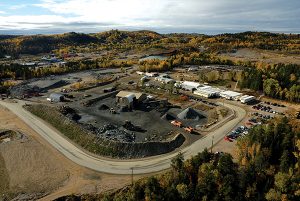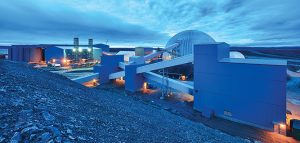Business of Top 40 Canadian miners shifts over years: 2017 edition

The McCreedy West nickel mine, in Ontario, was once owned by Inco. It was put on care and maintenance by KGHM in 2015. CREDIT: KGHM
CMJ published the first Top 40 list in 1989. This year we are taking a look back at how the list has changed in almost three decades. There were even some company names that I had forgotten in my 41 years as a mining industry observer.
Let’s take a look at some of the companies on that first list. If the names are not familiar to our younger readers, they can ask a grandparent.
Who remembers Cape Breton Development Corp., Lac Minerals, Corona Corp., Cassiar Mining, Brenda Mining, Kerr Addison Mines, Dickenson, or Cambior? Those names take some of us down memory lane. Any reader who can accurately list the commodities each of these produced is welcome to bonus points. Double points for anyone knowing who operates these particular properties today.
The largest Canadian miner by sales was Inco at $3.3 billion in 1989. Falconbridge was right behind at $2.1 billion, followed by Cominco at $1.7 billion, and Noranda at $1.5 billion. Good for the base metal miners.
The largest gold producer was Placer Dome in the No. 5 slot with $788 million.
Then came two uranium producers – Rio Algom with $712 million and Denison with $424 million.
Back to the base metals as Hudson Bay Mining & Smelting had sales of $409 million. Then Potash Corp. of Saskatchewan with $365 million and Fording Coal with $336 million rounding out the top 10.
For the next 15 years or so, base metal producers were regularly among the largest Canadian miners. Inco and Noranda were repeatedly in the top five. When Falconbridge wasn’t in the top five, it was in the top 10. Cominco, too, held a top 10 spot.
The sale of inco and Noranda/Falconbridge to foreign owners in 2006 changed the complexion of the top 10. Suddenly these companies no longer met our criteria for “Canadian.” The mines in Sudbury and Thompson were still producing nickel. Those in the rest of the country were producing copper and zinc. But they remain unreported because they are foreign-owned.
There are base metal producers on the rise such as First Quantum. Once it merged with FNX, it acquired to bulk to keep it in the top 10. Teck Resources is also one of the largest Canadian miners, and more power to it. With a global profile that includes base metals, coal and now oil sands, it is a good bet to remain in the top 10.
The coal producers that used to appear in the Top 40 have also dropped off. The reason is not necessarily foreign ownership, but rather due perhaps to a pair of trends.
One, coal revenue is now reported as part of a larger mining enterprise. Think Fording Coal, which used to report separately. Now, it’s represented as part of Teck Resources.
Two, coal is falling out of favour as a fuel. Ontario has eliminated coal-fired power plants, and the rest of the country is following suit. Thermal coal mining in Canada may someday be a thing of the past (as is asbestos mining).
The Ontario uranium industry exhausted its resources, and Elliot Lake became a retirement destination. Denison, stung by its foray into northeast B.C. coal, lost its major revenue source.
Cameco, with major uranium production in Saskatchewan almost always ranks in the top 10.
The Top 40 used to include steelmakers Dofasco and Stelco when they owned at least part of major iron ore mines. Ownership may return to Canadian hands, but reopening the mines is not an option. Even Iron Ore Company of Canada is now owned by foreigners, namely Rio Tinto.
PotashCorp has been in the top five or six with great regularity. And it is another fertilizer producer, Agrium, which has topped the rankings for five years running. Agrium’s stranglehold on the top spot seemed surprising at first. Then we looked at its performance since 1999 and realized it has consistently been in the top five except for 2001 when it was sixth.
When PotashCorp and Agrium merge under the Nutrien name, watch for the larger company to dominate the Top 40 again next year.
A notable change in the Top 40 over the last 10 years, is the rise of gold producers to higher rankings. The world’s largest producer of gold, Barrick, has been in second place since 2012 and regularly in the top 10 before that. Goldcorp, the number two gold producer, has risen into the top 10 in recent years and stayed there.
Agnico Eagle has risen through the list into top 10 territory the last two years. So has Kinross Gold. Yamana Gold has been a fixture in the top 10 to 15 rung of the ladder since 2012.
That leaves the oil sands miners, who have always been tricky to rank. Consolidations over the past few years make the job easier.
Suncor has the largest revenue, and the company breaks out its numbers for the oil sands only, which is a big help. Canadian Natural Resources is new to the list this year as the Horizon project matures and expands.
Comments from readers are always welcome either posted to our website or emailed to the staff.

Agnico Eagle Mines’ Meadowbank operation, in Nunavut. CREDIT: AGNICO EAGLE MINES
Comments